INSTITUT SUPERIEUR D'ANTHROPOLOGIE
INSTITUT OF ANTHROPOLOGY
COURS ONLINE – COURS A DISTANCE
INSCRIPTIONS OUVERTES
REGISTER NOW
EGYPTE – 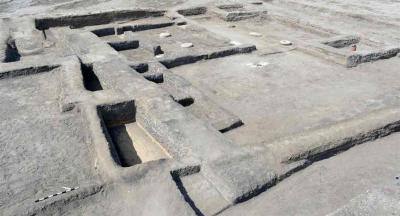 Tel Habwa - An Egyptian mission uncovered the ruins of a 3,500-year-old “royal fortified rest area” at the Tel Habwa archaeological site in the Northern i Sina Archaeological Area. Constructed of mud brick, it is thought to be one of the royal pa laces situated near the Eastern Gate of Egypt, likely built to accommodate ancient Egyptian forces, and perhaps even royalty, during the reign of Thutmose III (1479 to 1425 BC). The kings of ancient Egypt regularly launched military expeditions into the eastern Mediterranean during this time. The Sinai desert was one of the regular routes Egyptian troops took to reach this area. With a royal palace to house the king, the site was obviously strategically important for housing and resupplying troops as they traveled through the Sinai on their way to military campaigns. “It is likely that this building had been used as a royal respite due to the architectural planning of the building and the scarcity of pottery fractures [broken pottery] inside,” the Egyptian Ministry of Tourism and Antiquities said in a translated statement shared on their Facebook page. The Egyptian Archaeological Mission, operating at the Tel Habwa (Tharo) Archaeological Site, made this discovery during excavations as part of the Sinai Development Project. The architectural design of the old building in Sinai and the rarity of the pottery shards discovered inside suggest that it served as a royal resting place, the Egyptian Ministry of Tourism and Antiquities said. According to researchers, the pharaoh may have used the facility during his military campaigns to expand the Egyptian empire to the east. The building’s layout comprises two consecutive rectangular halls, along with several adjoining rooms. The main entrance, located on the north side, leads to the first hall, flanked by three limestone columns. The first hall is connected to another, smaller hall through doors on both the east and west sides. This smaller hall has two limestone columns in the middle, and the entrances are marked with stone thresholds. The second hall connects the two rooms that face east and west and is reached through entrances that are across from one another.The dating of the building was determined by stratigraphic layer analysis, pottery fragments discovered nearby, and the discovery of two inscribed cranes bearing the name Thutmose III, according to Professor Ramadan Helmy, Director of the North Sinai Archaeology Region and Head of the Mission. Archaeological work at the site also uncovered a number of burials, indicating that it was used as a cemetery during later periods in ancient Egyptian history.
Tel Habwa - An Egyptian mission uncovered the ruins of a 3,500-year-old “royal fortified rest area” at the Tel Habwa archaeological site in the Northern i Sina Archaeological Area. Constructed of mud brick, it is thought to be one of the royal pa laces situated near the Eastern Gate of Egypt, likely built to accommodate ancient Egyptian forces, and perhaps even royalty, during the reign of Thutmose III (1479 to 1425 BC). The kings of ancient Egypt regularly launched military expeditions into the eastern Mediterranean during this time. The Sinai desert was one of the regular routes Egyptian troops took to reach this area. With a royal palace to house the king, the site was obviously strategically important for housing and resupplying troops as they traveled through the Sinai on their way to military campaigns. “It is likely that this building had been used as a royal respite due to the architectural planning of the building and the scarcity of pottery fractures [broken pottery] inside,” the Egyptian Ministry of Tourism and Antiquities said in a translated statement shared on their Facebook page. The Egyptian Archaeological Mission, operating at the Tel Habwa (Tharo) Archaeological Site, made this discovery during excavations as part of the Sinai Development Project. The architectural design of the old building in Sinai and the rarity of the pottery shards discovered inside suggest that it served as a royal resting place, the Egyptian Ministry of Tourism and Antiquities said. According to researchers, the pharaoh may have used the facility during his military campaigns to expand the Egyptian empire to the east. The building’s layout comprises two consecutive rectangular halls, along with several adjoining rooms. The main entrance, located on the north side, leads to the first hall, flanked by three limestone columns. The first hall is connected to another, smaller hall through doors on both the east and west sides. This smaller hall has two limestone columns in the middle, and the entrances are marked with stone thresholds. The second hall connects the two rooms that face east and west and is reached through entrances that are across from one another.The dating of the building was determined by stratigraphic layer analysis, pottery fragments discovered nearby, and the discovery of two inscribed cranes bearing the name Thutmose III, according to Professor Ramadan Helmy, Director of the North Sinai Archaeology Region and Head of the Mission. Archaeological work at the site also uncovered a number of burials, indicating that it was used as a cemetery during later periods in ancient Egyptian history.
Archaeologists uncovered a 3,500-year-old Egyptian Royal Retreat in the Sinai Desert - Arkeonews
ANGLETERRE – 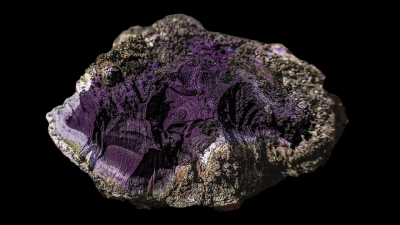 Carlisle - A rare archaeological object – thought to be the only one of its type in the former Roman Empire – has been discovered in Carlisle, England. The remnants of the Roman bathhouse at the Carlisle Cricket Club have revealed an extremely rare chunk of Tyrian purple dye, the first of its kind ever discovered in northern Europe and possibly the entire Roman Empire. The Luguvalium Roman settlement dates back to the 3rd century during the reign of Emperor Septimius Severus. The discovery was made in the drainage section of a monumental structure believed to be a Roman bathhouse. Known as “imperial purple,” tyrian purple was an extremely valuable dye in ancient Rome because of its rich, vivid color, which denoted imperial authority, wealth, and status. It took a lot of resources and labor-intensive procedures to produce even small amounts, as it was made from thousands of crushed sea snails (Bolinus brandaris) from the Mediterranean. This rarity and exclusivity meant that it was more valuable than gold, sometimes up to three times as much by weight. Following its discovery, the pigment was further investigated by specialists at the University of Newcastle and analyzed with assistance from the British Geological Society. The analysis showed that the pigment had high bromine and beeswax content, almost certainly proving that it was Tyrian purple. The discovery is noteworthy because Tyrian purple is rarely found in its solid state; the paint used in murals or on high-status coffins, such as those discovered in Pompeii and Roman Egypt, is the most common form of Tyrian purple discovery. Known as “imperial purple,” tyrian purple was an extremely valuable dye in ancient Rome because of its rich, vivid color, which denoted imperial authority, wealth, and status. It took a lot of resources and labor-intensive procedures to produce even small amounts, as it was made from thousands of crushed sea snails (Bolinus brandaris) from the Mediterranean. This rarity and exclusivity meant that it was more valuable than gold, sometimes up to three times as much by weight. Following its discovery, the pigment was further investigated by specialists at the University of Newcastle and analyzed with assistance from the British Geological Society. The analysis showed that the pigment had high bromine and beeswax content, almost certainly proving that it was Tyrian purple. The discovery is noteworthy because Tyrian purple is rarely found in its solid state; the paint used in murals or on high-status coffins, such as those discovered in Pompeii and Roman Egypt, is the most common form of Tyrian purple discovery.
Carlisle - A rare archaeological object – thought to be the only one of its type in the former Roman Empire – has been discovered in Carlisle, England. The remnants of the Roman bathhouse at the Carlisle Cricket Club have revealed an extremely rare chunk of Tyrian purple dye, the first of its kind ever discovered in northern Europe and possibly the entire Roman Empire. The Luguvalium Roman settlement dates back to the 3rd century during the reign of Emperor Septimius Severus. The discovery was made in the drainage section of a monumental structure believed to be a Roman bathhouse. Known as “imperial purple,” tyrian purple was an extremely valuable dye in ancient Rome because of its rich, vivid color, which denoted imperial authority, wealth, and status. It took a lot of resources and labor-intensive procedures to produce even small amounts, as it was made from thousands of crushed sea snails (Bolinus brandaris) from the Mediterranean. This rarity and exclusivity meant that it was more valuable than gold, sometimes up to three times as much by weight. Following its discovery, the pigment was further investigated by specialists at the University of Newcastle and analyzed with assistance from the British Geological Society. The analysis showed that the pigment had high bromine and beeswax content, almost certainly proving that it was Tyrian purple. The discovery is noteworthy because Tyrian purple is rarely found in its solid state; the paint used in murals or on high-status coffins, such as those discovered in Pompeii and Roman Egypt, is the most common form of Tyrian purple discovery. Known as “imperial purple,” tyrian purple was an extremely valuable dye in ancient Rome because of its rich, vivid color, which denoted imperial authority, wealth, and status. It took a lot of resources and labor-intensive procedures to produce even small amounts, as it was made from thousands of crushed sea snails (Bolinus brandaris) from the Mediterranean. This rarity and exclusivity meant that it was more valuable than gold, sometimes up to three times as much by weight. Following its discovery, the pigment was further investigated by specialists at the University of Newcastle and analyzed with assistance from the British Geological Society. The analysis showed that the pigment had high bromine and beeswax content, almost certainly proving that it was Tyrian purple. The discovery is noteworthy because Tyrian purple is rarely found in its solid state; the paint used in murals or on high-status coffins, such as those discovered in Pompeii and Roman Egypt, is the most common form of Tyrian purple discovery.
Incredibly Rare Tyrian Purple Discovered at Carlisle Roman bathhouse - Arkeonews
INDE - Bahaj - The Archaeological Survey of India (ASI) has found a 2,500-year-old 'yagya kund', along with metal tools and coins among other ancient articles during the excavation of a mound in Bahaj village of Deeg Tehsil in Rajasthan's Bharatpur division. Evidence of religious rituals like Yagya being performed thousands of years ago has also been found in the excavations. The soil taken out from the Havan Kund is kept separate, considered to be of special significance. During the excavation, tools made from bones and ancient baked clay sculptures from the Mauryan period have also been found. A pair of statues of Ashwani Kumar, also known as twin Hindu gods associated with medicine, health, dawn, and the sciences, have been found which belong to the Sunga period. The names of Ashwini Kumar in Mahabharata are Dstra and Nasatya. Till now, no evidence of the twin gods has been found in India before 700 BC. However, for the first time, this evidence from 200 BC has been found in Bahaj village, said officials. Idol plates of Ashwani Kumar of Sunga period and tools made Pits contain sacrificial soil, which is natural sandy soil, along with offering of miniature pots in different shapes, sometime containing copper coins wrapped in cloth, and also copper and iron objects have been discovered. from bones and fragments of pottery believed to be from Mahabharata period have also been found.
2,500-year-old 'yagya kund' found during excavation in Rajasthan's Braj region - Daijiworld.com
ALLEMAGNE – 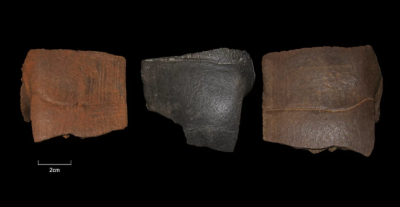 Magdeburg - Experts have recovered around 50,000-year-old turtle shell fragments from the Barleben-Adamsee gravel pit near Magdeburg. The turtles could have been easily transportable food reserves. The numerous gravel pits in the middle Elbe valley near Magdeburg have already yielded many special archaeological finds from the period between the Middle Pleistocene (Ice Age) and modern times. In the Adamsee lake area near Barleben (Börde district), gravel accumulation occurred over a period of several tens of thousands of years. Since gravel extraction is conducted with bucket dredgers below the water table, observing the find layers is not possible. Not only around 180 flint artifacts have been recovered from the Adamsee (including hand axes, other tools, cores and flakes), but a very special find also came from the gravel pit. As early as 1998/99, a 41.8 centimeter long tip made from the rib of a bovid (aurochs or bison) was discovered. One end of the bone has been very carefully prepared in the form of a long, slender point approximately twelve centimeters long. Radiocarbon dating places the animal’s time of death with 95 percent probability between 32,992 and 32,406 BC, in the late Middle or early Upper Paleolithic period. This makes the find one of the oldest ground bone tools in Central Germany. The stone implements belong to the same period. Among them is, for example, the fragment of a bifacial leaf point, which can be compared with finds from the Ilsenhöhle near Ranis in Thuringia. A team of researchers with the participation of the Saxony-Anhalt State Office for Heritage Management and Archaeology recently identified early modern humans as manufacturers of these devices 45,000 years ago. Previously, the leaf points had often been associated with Neanderthals. Among the more recent finds from Adamsee, five fragments of turtle shells that can be assigned to the European pond turtle (Emys orbicularis) stand out. All fragments were dated twice using the radiocarbon method. The age is between around 50,000 and 42,000 years BP. The turtles therefore lived during the Weichselian Glacial, a date that was unexpected for Central Europe. The eggs of the European pond turtle, which are laid in the ground, require a temperature of more than 18 to 20 degrees Celsius for embryonic growth. The Barleben-Adamsee finds are therefore likely to be outside of the natural range of the European pond turtle at that time, which raises the question of their origin. Ethnographic and historical comparisons show that people often took turtles with them when traveling as provisions, as “living tins” so to speak. The animals are easily transportable and provide a supply of fresh meat even if the hunt is unsuccessful. It is possible that Ice Age hunters – Neanderthals or modern humans – brought the turtles with them to northern, cool regions. Future research will have to prove whether this is actually the case.
Magdeburg - Experts have recovered around 50,000-year-old turtle shell fragments from the Barleben-Adamsee gravel pit near Magdeburg. The turtles could have been easily transportable food reserves. The numerous gravel pits in the middle Elbe valley near Magdeburg have already yielded many special archaeological finds from the period between the Middle Pleistocene (Ice Age) and modern times. In the Adamsee lake area near Barleben (Börde district), gravel accumulation occurred over a period of several tens of thousands of years. Since gravel extraction is conducted with bucket dredgers below the water table, observing the find layers is not possible. Not only around 180 flint artifacts have been recovered from the Adamsee (including hand axes, other tools, cores and flakes), but a very special find also came from the gravel pit. As early as 1998/99, a 41.8 centimeter long tip made from the rib of a bovid (aurochs or bison) was discovered. One end of the bone has been very carefully prepared in the form of a long, slender point approximately twelve centimeters long. Radiocarbon dating places the animal’s time of death with 95 percent probability between 32,992 and 32,406 BC, in the late Middle or early Upper Paleolithic period. This makes the find one of the oldest ground bone tools in Central Germany. The stone implements belong to the same period. Among them is, for example, the fragment of a bifacial leaf point, which can be compared with finds from the Ilsenhöhle near Ranis in Thuringia. A team of researchers with the participation of the Saxony-Anhalt State Office for Heritage Management and Archaeology recently identified early modern humans as manufacturers of these devices 45,000 years ago. Previously, the leaf points had often been associated with Neanderthals. Among the more recent finds from Adamsee, five fragments of turtle shells that can be assigned to the European pond turtle (Emys orbicularis) stand out. All fragments were dated twice using the radiocarbon method. The age is between around 50,000 and 42,000 years BP. The turtles therefore lived during the Weichselian Glacial, a date that was unexpected for Central Europe. The eggs of the European pond turtle, which are laid in the ground, require a temperature of more than 18 to 20 degrees Celsius for embryonic growth. The Barleben-Adamsee finds are therefore likely to be outside of the natural range of the European pond turtle at that time, which raises the question of their origin. Ethnographic and historical comparisons show that people often took turtles with them when traveling as provisions, as “living tins” so to speak. The animals are easily transportable and provide a supply of fresh meat even if the hunt is unsuccessful. It is possible that Ice Age hunters – Neanderthals or modern humans – brought the turtles with them to northern, cool regions. Future research will have to prove whether this is actually the case.
Ice Age turtle finds near Magdeburg point to canned food from the Stone Age - Arkeonews
AUTRICHE – 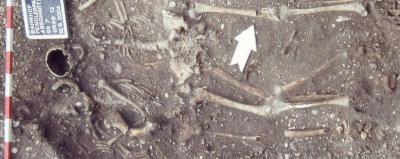
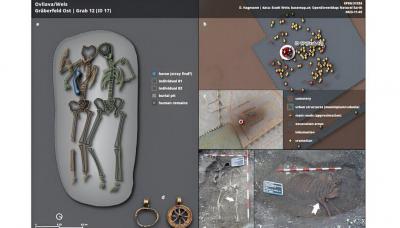
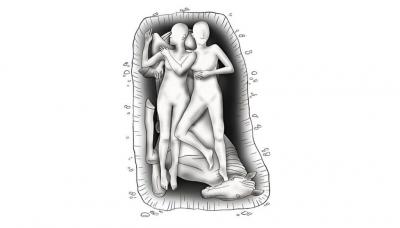 Ovilava - In 2004, an unusual grave was discovered during construction work in the area of the so-called eastern burial ground of the ancient Roman city of Ovilava – today’s Wels in Upper Austria. It contained the remains of two people embracing each other and at least one horse. Due to these unusual features, the find was initially thought to be an early medieval double burial. A comprehensive new investigation, in which the latest bioarchaeological and archaeogenetic methods were used, revealed surprising findings: The grave is 500 years older than previously thought. It dates from the 2nd to 3rd century AD and can therefore be assigned to Roman antiquity in Austria, report anthropologist Sylvia Kirchengast and archaeologist Dominik Hagmann in a study published in the “Journal of Archaeological Science: Reports” “In Roman times, burials in which people were buried next to horses were very rare. But what is even more extraordinary is that this is the first burial from Roman antiquity in Austria in which genetic analyzes were able to clearly identify a biological mother and her biological daughter, who were buried at the same time. This makes our results particularly exciting,” explains Dominik Hagmann, lead author of the study. Osteological findings in conjunction with new research methods such as the analysis of ancient DNA revealed the biological sex and also suggested a family connection between the two human individuals. Radiocarbon dating finally enabled a more precise chronological classification of both the human skeletons and the horse skeleton. The detailed examination of the golden grave goods provided additional information for the new dating of the site. Archaeozoological examinations of the buried horse expanded our understanding of the entire burial context. “In summary, our investigations showed that the burial was of two biological women—probably a mother aged around 40 to 60 and her daughter aged around 20 to 25—from the second and third centuries. “The grave is around 500 years older than initially assumed and clearly dates from Roman times,” says study director Sylvia Kirchengast. The exact background of the double burial is not clear, the scientists’ theory is that both may have died of an illness at the same time and, according to a tradition from the late Iron Age, were buried together with their horse—the older person has skeletal features that indicate frequent riding could.
Ovilava - In 2004, an unusual grave was discovered during construction work in the area of the so-called eastern burial ground of the ancient Roman city of Ovilava – today’s Wels in Upper Austria. It contained the remains of two people embracing each other and at least one horse. Due to these unusual features, the find was initially thought to be an early medieval double burial. A comprehensive new investigation, in which the latest bioarchaeological and archaeogenetic methods were used, revealed surprising findings: The grave is 500 years older than previously thought. It dates from the 2nd to 3rd century AD and can therefore be assigned to Roman antiquity in Austria, report anthropologist Sylvia Kirchengast and archaeologist Dominik Hagmann in a study published in the “Journal of Archaeological Science: Reports” “In Roman times, burials in which people were buried next to horses were very rare. But what is even more extraordinary is that this is the first burial from Roman antiquity in Austria in which genetic analyzes were able to clearly identify a biological mother and her biological daughter, who were buried at the same time. This makes our results particularly exciting,” explains Dominik Hagmann, lead author of the study. Osteological findings in conjunction with new research methods such as the analysis of ancient DNA revealed the biological sex and also suggested a family connection between the two human individuals. Radiocarbon dating finally enabled a more precise chronological classification of both the human skeletons and the horse skeleton. The detailed examination of the golden grave goods provided additional information for the new dating of the site. Archaeozoological examinations of the buried horse expanded our understanding of the entire burial context. “In summary, our investigations showed that the burial was of two biological women—probably a mother aged around 40 to 60 and her daughter aged around 20 to 25—from the second and third centuries. “The grave is around 500 years older than initially assumed and clearly dates from Roman times,” says study director Sylvia Kirchengast. The exact background of the double burial is not clear, the scientists’ theory is that both may have died of an illness at the same time and, according to a tradition from the late Iron Age, were buried together with their horse—the older person has skeletal features that indicate frequent riding could.
The first mother-daughter burial from the Roman period found in Austria - Arkeonews
CHINE – 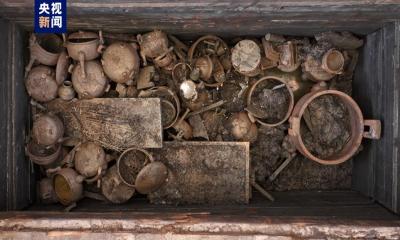
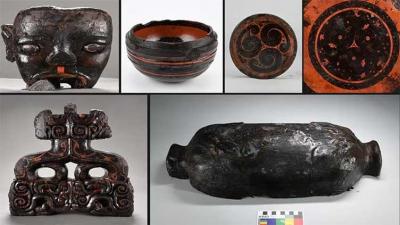 Huainan - Archaeologists have unearthed a luxurious 2,200-year-old tomb in eastern China, the largest, highest-ranking, and most structurally complex ever unearthed, which may have belonged to an emperor of the state of Chu during a critical period in Chinese history. Chu was one of the seven Warring States, along with Qin, Han, Wei, Zhao, Qi, and Yan. The unification of these states is recognized as the start of modern China. The 2,200-year-old Wuwangdun tomb, which is situated in the Anhui Province of East China’s city of Huainan, has yielded over 1,000 artifacts, including figurines, musical instruments, bronze goods, and everyday utensils and lacquerware artifacts, dating to about 220 BC. At Wuwangdun, one of the largest-scale Chu state archaeological sites, researchers previously uncovered a cemetery spanning 1.5sqkm, with a chariot and sacrifice pits and a tomb, believed to be that of the cemetery’s owner. The tomb is thought to be the highest-level ancient Chu state tomb ever excavated, and its vast scale, intricate structure, and rich contents suggest it belonged to the state’s emperor. he Wuwangdun tomb complex, which covers an area of over 140 square kilometers, includes sacrificial pits, chariot and horse pits, accompanying graves, and the main burial chamber (Tomb No. 1). Tomb No. 1 is a large, nearly square, vertical pit tomb with sides that are about 50 meters long. There is a 42-meter-long, sloping tomb passage on the east side. Around the pit, eight side chambers were found, and a central coffin chamber with several layers of planks covering it was also found. 443 coffin lid planks and the 78 bamboo mats that covered them have been removed thus far. On the planks of the coffin lid, there were about 1,00These discoveries provide systematic archaeological data for studying the high-level tomb system in the Chu state during the late Warring States period (475BC-221BC). 0 ink-drawn characters that represented the locations and purposes of each side chamber.
Huainan - Archaeologists have unearthed a luxurious 2,200-year-old tomb in eastern China, the largest, highest-ranking, and most structurally complex ever unearthed, which may have belonged to an emperor of the state of Chu during a critical period in Chinese history. Chu was one of the seven Warring States, along with Qin, Han, Wei, Zhao, Qi, and Yan. The unification of these states is recognized as the start of modern China. The 2,200-year-old Wuwangdun tomb, which is situated in the Anhui Province of East China’s city of Huainan, has yielded over 1,000 artifacts, including figurines, musical instruments, bronze goods, and everyday utensils and lacquerware artifacts, dating to about 220 BC. At Wuwangdun, one of the largest-scale Chu state archaeological sites, researchers previously uncovered a cemetery spanning 1.5sqkm, with a chariot and sacrifice pits and a tomb, believed to be that of the cemetery’s owner. The tomb is thought to be the highest-level ancient Chu state tomb ever excavated, and its vast scale, intricate structure, and rich contents suggest it belonged to the state’s emperor. he Wuwangdun tomb complex, which covers an area of over 140 square kilometers, includes sacrificial pits, chariot and horse pits, accompanying graves, and the main burial chamber (Tomb No. 1). Tomb No. 1 is a large, nearly square, vertical pit tomb with sides that are about 50 meters long. There is a 42-meter-long, sloping tomb passage on the east side. Around the pit, eight side chambers were found, and a central coffin chamber with several layers of planks covering it was also found. 443 coffin lid planks and the 78 bamboo mats that covered them have been removed thus far. On the planks of the coffin lid, there were about 1,00These discoveries provide systematic archaeological data for studying the high-level tomb system in the Chu state during the late Warring States period (475BC-221BC). 0 ink-drawn characters that represented the locations and purposes of each side chamber.
Luxurious 2,200-year-old King Tomb Discovered in China - Arkeonews